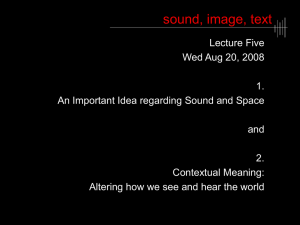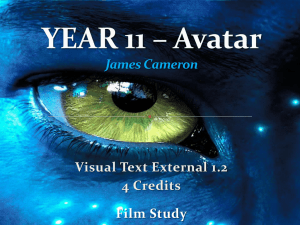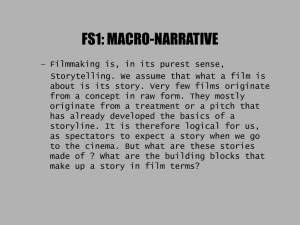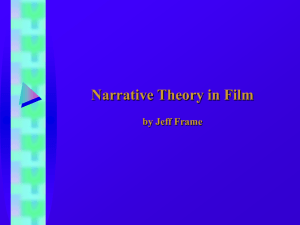Narrative Form - Alliance Gertz
advertisement
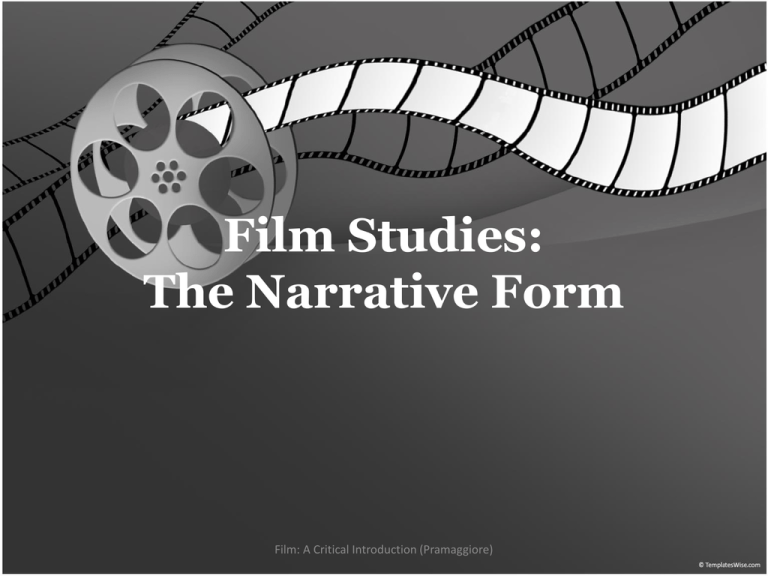
Film Studies: The Narrative Form Film: A Critical Introduction (Pramaggiore) Defining Narrative A narrative is • an account of a string of events occurring in space and time (setting). Not merely a cluster of random elements, a narrative • presents an ordered series of events connected by the logic of cause and effect. Film: A Critical Introduction (Pramaggiore) A narrative may be factual or fictional, or a blend of the two. Case Study: The Matrix • Neo learns that the Matrix controls human life (cause), he decides to join Morpheus and Trinity in their quest to defeat it (effect). • Neo’s character traits, including his values and beliefs, contribute to his decision. A different character might refuse to get involved, preferring the false sense of security the Matrix provides. Film: A Critical Introduction (Pramaggiore) Another Case Study: Let’s Watch! http://www.youtube.com/watch?v=CLOP3_cjr8k This narrative shows selected chronologically arranged events in the life of a few characters. 1. Celebrate anniversary in the French Riviera 2. Husband goes first. 3. Husband arrives at the hotel. 4. Husband emails wife. 5. … 6. Etc. Film: A Critical Introduction (Pramaggiore) Review Vocab thus far… • Event: In a narrative either an action by a character or person or a happening. • Setting: The place where filmed action occurs. • Sequence: A series of related consecutive scenes, perceived as a major unit of a narrative film. Film: A Critical Introduction (Pramaggiore) Narrative piece events together in a linear fashion (first, second, third…) that clearly shows the audience the reasons for, and the consequences of, character behavior. This logic of cause and effect ties together character traits, goals, obstacles, and actions. Film: A Critical Introduction (Pramaggiore) Narrative films generally focus on human characters and their struggles. Characters possess traits, face conflicts, perform action, and undergo changes that enable or hinder their pursuit of a specific goal. Film: A Critical Introduction (Pramaggiore) The goal may be concrete or abstract, lofty or banal: in some cases it may be finding love; in others it may be saving humanity or arriving safely at a destination. Film: A Critical Introduction (Pramaggiore) Quick Review… • A narrative film includes at least one character and events; its settings may be factual or imaginary. • The central character (protagonist) has one or more goals but faces problems in trying to reach them. Film: A Critical Introduction (Pramaggiore) Diegetic and Non-Diegetic Elements Narrative films often include elements that exist outside the fictional world of the story-such as the opening or closing credits, or background music. The implied world of the story, including setting, characters, sounds, and events, is the diegesis. Film: A Critical Introduction (Pramaggiore) Diegetic and Non-Diegetic Elements Elements that exist outside the diegesis are called non-diegetic or extradiegetic devices. The audience is aware of these nondiegetic components of the film, but the characters, are not. Film: A Critical Introduction (Pramaggiore) Diegetic and Non-Diegetic Elements Filmmakers use non-diegetic elements for several reasons: • Draw attention to aspects of the narrative from a position outside a story • Communicate with the audience directly • Engage viewers on an emotional level Film: A Critical Introduction (Pramaggiore)



